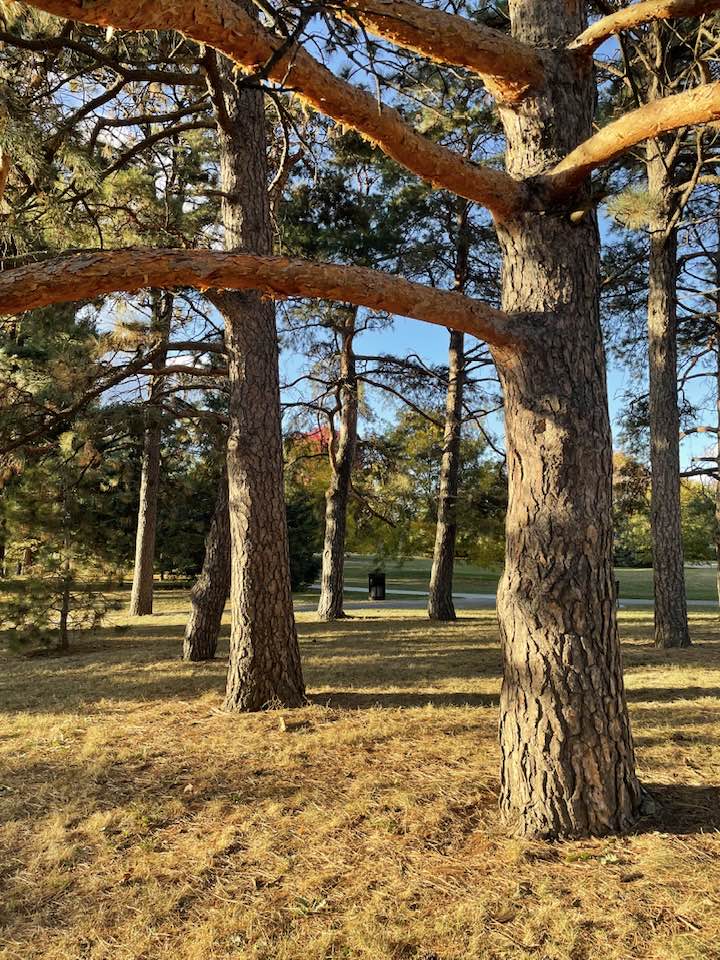OCTOBER 6, 2022 – Lately, several people have recommended that I read The Hidden Life of Trees by Peter Wohlleben. These recommendations supplement the many earlier endorsements I’d received over the years from friends. In fact, I’ve read the book, and found it important enough to add to my “re-read” stack. If you haven’t read this gem, I recommend that you do—bearing in mind, ironically, that the hard-copy version, like so many other things that touch our lives, including essentials like toilet paper, is made from the corpses of . . . trees.
Even before reading the book, I’d learned to see trees as analogous to . . . us. Whenever I walked among trees, I saw each as a person; a grove, as a clutch; a forest, as a crowd. Then came the weekends at Björnholm, when I planted the first 300 of over 500 seedlings—mostly white pine; a few balsam and Eastern hemlocks. Using my dad’s old-but-good planting bar, I labored hard to make a wedge-shaped hole in the ground for each seedling. None was easy. The planting area had been logged recently. Just below the surface was a chaotic world of stones, roots, and unyielding soil. Usually I’d have to jam the planting bar several times before finding a suitable spot. Then, after planting my knees on the earth and teasing the roots of a seedling into the slot, I’d again have to sink the planting bar into the ground—near the hole—to close the opening. Each seedling took at least five minutes, often more, to plant.
The totality of the experience brought me closer to “the hidden life of trees,” even before I read the illuminating book bearing that title.
Today I thought about the book, the woods, and the seedlings—now saplings, many six or more feet tall. The reminders, however, weren’t trees, groves, or woods close to home (see yesterday’s post). This time, instead of trees reminding me of humanity, people reminded me of trees.
You might say, “It was bound to happen!”
My interactions today included lengthy phone conversations with a dozen people, correspondence with several more, and direct conversations with three others, including my spouse and a next door neighbor. Each person was like a tree with its many aspects—bark, leaves, boughs and branches, and so many other features common to all members of the species, yet also unique to the individual.
By this person-as-tree imagery I gained newfound regard for old friends—just as by the converse metaphor I’d acquired a new affinity for trees I’d long taken for granted. The friend who’s withstood many storms now looks like a mighty oak; the comrade whose far-reaching interests and insights brightly enrich my life is like the beautiful black walnut I saw in the park today—its broad, yellow crown reflecting a burst of morning sunshine; the sister whose wide horizons never fail to expand my own worldview is like the towering white pine that looks with ease over the surrounding treetops. My wife, whose talent for design, balance, and color is equal to her raw intelligence and unassailable integrity, is like the brilliant, symmetrical red maple, unequivocal in the honesty of its stance.
May you too find delight in seeing people as trees—and trees as people.
(Remember to subscribe to this blog and receive notifications of new posts by email.)
© 2022 by Eric Nilsson

2 Comments
Eric, I am delighted that you started a grove of Eastern hemlock. I did, too, near Spooner, because of the hemlock blight which is decimating the Appalachians. I no longer own the property near Spooner, so I can only hope that the new owners are preserving them. Around Saint Paul, I have been planting lots of little oak trees, often from acorns which I baby along and protect from squirrels. I love your comparison of trees to people (something I agree with), but please, do not compare your wife to a red maple. They are overwhelming the white pine forests (to the extent they still exist) in the northland. So you make your wife sound like a common nuisance, which I know she is not.
Ginny! I’ve seen those Eastern hemlock forests ravaged by the blight (along the Delaware River between northern NJ and PA)–heartbreaking to see. As to the red maple, I’ve not observed–and didn’t know–about the red maple crowding out the white pine. On our property on Grindstone, red maple exist, but not in such numbers that I’d ever think them to be a nuisance. The white pine, however, have been hit hard by infestations and blister rust. I’m doing my best to control those effects. – Eric
Comments are closed.